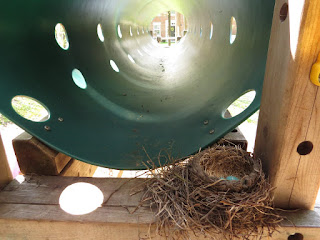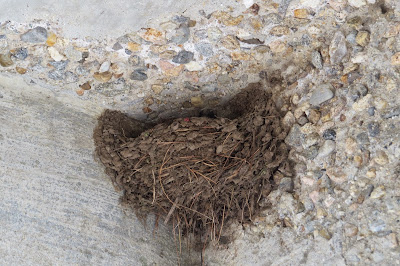When a Free Day falls during the peak of spring migration, it's time to get out there and go birding. Saturday, May 14, 2016 also happened to be the "Global Big Day" organized by the Cornell Lab of Ornithology and eBird, the digital database of bird sightings, so all species observed at Middlesex this morning were logged and uploaded for the world to see, while across the globe thousands of other birders did the same. It was a banner day for campus birds, with an all time high of 76 species seen or heard on school grounds over the course of four hours. A highlight was a calling pair of Virgina Rails, which aren't too rare but tend to be secretive. They are more often heard than seen, and this pair was close enough for their duet of grunt calls to be recorded by an iPhone. Listen here (pump up the volume) to the rails and a few Red-winged Blackbirds in the background. Below is the full list, as generated by the eBird iPhone app.
Middlesex School, Middlesex, Massachusetts, US
May 14, 2016 4:29 AM - 8:30 AM
Protocol: Traveling
3.0 mile(s)
Comments: All birds observed on Middlesex School grounds, including Bateman's Pond, school property between Lowell Road and Spencer Brook, and the cross country trail through portions of Estabrook Woods near the east fields. Excellent variety, record high daily species total for campus.
76 species
Canada Goose 6
Wood Duck 4
Mallard 3
Wild Turkey 1 Distant gobbling heard from near main entrance.
Double-crested Cormorant 2 Flyover
Great Blue Heron 4 1 on Bateman's, 3 flyover at Spencer Brook.
Green Heron 1 Flyover, Bateman's dock.
Turkey Vulture 1
Cooper's Hawk 2 1 imm. being harassed by crows on the circle; 1 adult in display flight over Estabrook.
Broad-winged Hawk 2
Red-tailed Hawk 1
Virginia Rail 2 Grunting duet in Bateman's marsh by main entrance. Seen and recorded.
Killdeer 3
Spotted Sandpiper 1 Bateman's dock
Mourning Dove 8
Chimney Swift 8
Ruby-throated Hummingbird 1
Red-bellied Woodpecker 4
Downy Woodpecker 5
Hairy Woodpecker 2
Northern Flicker (Yellow-shafted) 1
Pileated Woodpecker 1 Heard only, across the pond
Eastern Wood-Pewee 1
Least Flycatcher 1
Eastern Phoebe 5
Great Crested Flycatcher 2
Eastern Kingbird 4
Warbling Vireo 6
Red-eyed Vireo 3
Blue Jay 4
American Crow 2
Tree Swallow 8
Barn Swallow 5
Black-capped Chickadee 12
Tufted Titmouse 8
White-breasted Nuthatch 4
House Wren 1
Carolina Wren 1
Blue-gray Gnatcatcher 4
Eastern Bluebird 3 Lindsay Pond
Veery 5
Swainson's Thrush 1
Hermit Thrush 2
Wood Thrush 2
American Robin 14
Gray Catbird 13
European Starling 7
Cedar Waxwing 4
Ovenbird 8
Northern Waterthrush 1 Singing from NE Bateman's swamp, behind library.
Blue-winged Warbler 1
Black-and-white Warbler 3
Common Yellowthroat 4
American Redstart 2
Northern Parula 5
Magnolia Warbler 3
Blackburnian Warbler 1
Yellow Warbler 6
Pine Warbler 1
Yellow-rumped Warbler (Myrtle) 1
Black-throated Green Warbler 2
Chipping Sparrow 9
Song Sparrow 10
Swamp Sparrow 5
Scarlet Tanager 3
Northern Cardinal 4
Rose-breasted Grosbeak 5
Indigo Bunting 1
Bobolink 2 Singing flyovers, Spencer Brook field.
Red-winged Blackbird 11
Common Grackle 18
Brown-headed Cowbird 5
Baltimore Oriole 8
House Finch 3
American Goldfinch 5
House Sparrow 3
May 14, 2016 4:29 AM - 8:30 AM
Protocol: Traveling
3.0 mile(s)
Comments: All birds observed on Middlesex School grounds, including Bateman's Pond, school property between Lowell Road and Spencer Brook, and the cross country trail through portions of Estabrook Woods near the east fields. Excellent variety, record high daily species total for campus.
76 species
Canada Goose 6
Wood Duck 4
Mallard 3
Wild Turkey 1 Distant gobbling heard from near main entrance.
Double-crested Cormorant 2 Flyover
Great Blue Heron 4 1 on Bateman's, 3 flyover at Spencer Brook.
Green Heron 1 Flyover, Bateman's dock.
Turkey Vulture 1
Cooper's Hawk 2 1 imm. being harassed by crows on the circle; 1 adult in display flight over Estabrook.
Broad-winged Hawk 2
Red-tailed Hawk 1
Virginia Rail 2 Grunting duet in Bateman's marsh by main entrance. Seen and recorded.
Killdeer 3
Spotted Sandpiper 1 Bateman's dock
Mourning Dove 8
Chimney Swift 8
Ruby-throated Hummingbird 1
Red-bellied Woodpecker 4
Downy Woodpecker 5
Hairy Woodpecker 2
Northern Flicker (Yellow-shafted) 1
Pileated Woodpecker 1 Heard only, across the pond
Eastern Wood-Pewee 1
Least Flycatcher 1
Eastern Phoebe 5
Great Crested Flycatcher 2
Eastern Kingbird 4
Warbling Vireo 6
Red-eyed Vireo 3
Blue Jay 4
American Crow 2
Tree Swallow 8
Barn Swallow 5
Black-capped Chickadee 12
Tufted Titmouse 8
White-breasted Nuthatch 4
House Wren 1
Carolina Wren 1
Blue-gray Gnatcatcher 4
Eastern Bluebird 3 Lindsay Pond
Veery 5
Swainson's Thrush 1
Hermit Thrush 2
Wood Thrush 2
American Robin 14
Gray Catbird 13
European Starling 7
Cedar Waxwing 4
Ovenbird 8
Northern Waterthrush 1 Singing from NE Bateman's swamp, behind library.
Blue-winged Warbler 1
Black-and-white Warbler 3
Common Yellowthroat 4
American Redstart 2
Northern Parula 5
Magnolia Warbler 3
Blackburnian Warbler 1
Yellow Warbler 6
Pine Warbler 1
Yellow-rumped Warbler (Myrtle) 1
Black-throated Green Warbler 2
Chipping Sparrow 9
Song Sparrow 10
Swamp Sparrow 5
Scarlet Tanager 3
Northern Cardinal 4
Rose-breasted Grosbeak 5
Indigo Bunting 1
Bobolink 2 Singing flyovers, Spencer Brook field.
Red-winged Blackbird 11
Common Grackle 18
Brown-headed Cowbird 5
Baltimore Oriole 8
House Finch 3
American Goldfinch 5
House Sparrow 3































